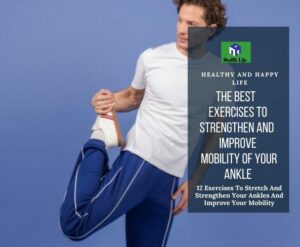Mobility of the ankle refers to the degree to which the ankle joint and the muscles and tendons that surround it are flexible. When you have flexibility in your ankle, it allows you a broader range of motion in the activities you participate in. Continue reading more, here we are going to examine about what are the main ankle mobility stretches exercises to strength the ankles.
You may enhance your mobility and strength by doing ankle exercises and stretching. This is especially helpful if your ankles are weak, or if you want to improve your athletic performance.
Your efforts to strengthen and stretch your ankles as part of your everyday routine will pay off in the form of reduced risk of injury. Developing your ankle strength will not only improve your gait but will also avoid the deterioration of the muscles in your knees and hips.
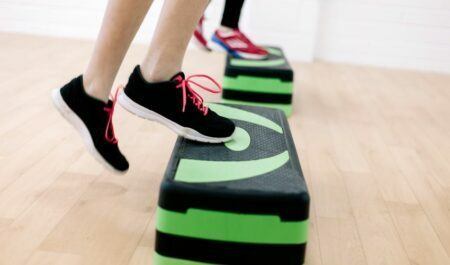
Include the following 12 ankle exercises in your program anywhere from three to five times each week.
Ankle Circles.
First, give your muscles a good stretch. You may improve your range of motion by performing these circles, which can be done either seated or lying down.
- Place a cloth or foam roller that has been rolled up beneath your ankle.
- Slowly turn your ankle in circles, first clockwise for ten revolutions and then counterclockwise for ten revolutions.
- Only your foot and ankle should move; your leg should remain still.
- You may change the range of motion of the stretch by tracing the letters of the alphabet with your big toe.
Additional ankle stretches are available on this page.
Single Leg Balancing.
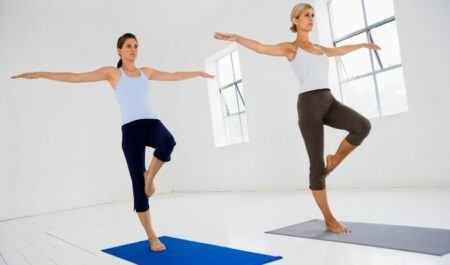
- Place your feet shoulder-width apart on a level surface and stand in this position. If you feel like you need assistance, you should have a chair or a wall nearby.
- Stand on one foot while holding your arms out to the sides of your body.
- Perform this exercise on a regular basis and work on increasing the amount of time that you can remain stable on each leg.
- If you are already able to stand on one foot for one minute, you can progress to one of the following variations:
- Maintain your equilibrium while closing your eyes.
- maintain your equilibrium by keeping your arms by your sides.
- standing on an unstable surface such as a cushion, folded towel, or balancing disc requires you to maintain your equilibrium.
In addition to incorporating it into your regular routine, you may do this workout every day. For instance, try standing on one foot while you wash your teeth or while you are waiting in line. This can help strengthen your core and improve your balance.
Standing Heel Raises.
- Maintain a shoulder-width distance between your feet when you stand. If you feel like you need assistance, you can lean against a neighboring chair or the wall.
- Raise your heels off the ground and stand on the balls of your feet rather than the soles of your feet.
- Bring your heels down to the floor in a slow and steady motion. Maintaining control of your movements is essential for improving your muscular strength.
- Perform two or three sets of ten lifts in each.
- Holding free weights in each hand while performing this exercise will provide an additional source of resistance.
You may include this workout into your normal activities, such as while you’re doing the dishes or walking the dog.
Toe Raises And Heel Drops On A Step
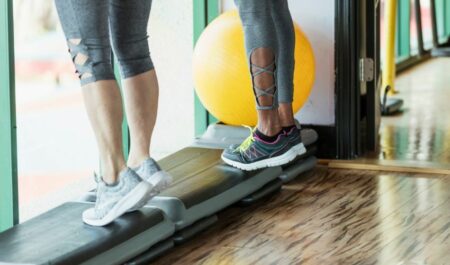
Because it requires more flexion of the ankle, this exercise is more difficult than the heel lift that is performed on the floor.
- Place your weight on the balls of your feet while standing on the lowest step, and allow your heels to dangle off the edge of the step. If you feel like you need more support, you can lean against a bannister.
- First, raise yourself up onto your toes, and then gently lower your feet until your heels are below the level of the step.
- Every other day, perform two or three sets of ten repetitions of each lift.
- While performing toe rises, you may increase the challenge by gripping weights in either hand.
Ankle Flexion (Plantar).
As you draw your toes closer to your heel and point them downward, this exercise will help you build stronger ankles by utilizing a resistance band (plantar flexion).
- Place one heel on the ground while sitting on the floor with one knee bent and the other leg resting comfortably on the ground. Observe the position of your foot.
- Wrap the band over the top of your foot, and then grasp both ends of the band in your hands.
- You should point your toes softly forward, and then back, to release any tension that may be there.
- Flex your feet three times a week, doing three sets of ten on each foot.
Ankle Flexion (Dorsiflexion).
During this workout, you will flex your ankle by drawing your toes toward you while wearing a stretch band (dorsiflexion).
- Place yourself on the ground in a seated position with your legs out in front of you.
- First, fasten the band securely around the leg of a chair or a table, and then wrap it once around each foot.
- Bring your toes slowly toward you while pointing them upward, and then return to the beginning position.
- Flex your feet three times a week, doing three sets of ten on each foot.
Toe-Heel Walking.
This is a workout that may be performed with or without shoes. Your feet and ankles will become more robust as a result of this.
- Walk around 30 feet standing on your toes without touching the ground.
- You need to move backwards while standing on your heels, so turn around.
- Repeat three to five times.
You may also include a portion of this workout into your regular regimen to make it more convenient. For instance, you may try going around the kitchen on your toes.
Lunges (Static).
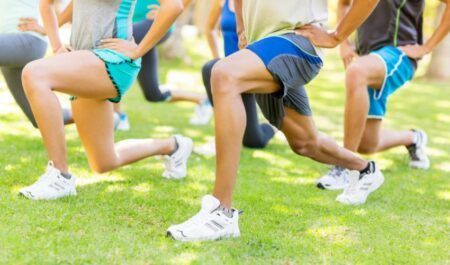
Lunges help you improve your balance and strengthen your ankles at the same time. There are several variations of the lunge exercise. You should probably start out light and gradually increase the level of difficulty as you get better. Start off by performing lunges while standing still, often known as a static lunge.
- To begin, place one foot in front of the other and turn your toes so that they face front.
- Always remember to have a straight back.
- Bring the knee that is behind you down so that it is almost touching the floor.
- The next step is to pull yourself back up.
- Perform two sets and ten repetitions of this exercise.
Try switching up the position of your leading leg and the static lunge. In between each round of lunges, take three steps forward, then switch the leg that is in front.
Walking Lunge.
The walking lunge is a more difficult exercise to perform. The exercise targets both the core and the lower body. It is recommended that you have a personal trainer or another workout specialist fix your technique when you are first attempting this maneuver.
- Take a step forward with one leg while bending the knee of the back leg to a right angle.
- At the same moment, bring the knee that is located behind you down to the floor. It should feel as though your thigh is almost completely parallel to the ground.
- Keep your body in that position for a few of seconds.
- After that, bring your rear leg forward one step, and perform the lunge again, this time leading with the front leg.
- Perform up to ten lunges on each of your legs.
Plyometrics.
The term “plyometrics” refers to a category of workouts that incorporate leaping motions. They are constructed in such a way that your muscles will attain their maximum force in the shortest amount of time feasible.
These exercises demand a minimum amount of initial physical strength; thus, you should begin by moving gently. Because proper form is essential when performing them, you might find it helpful to have a personal trainer or another fitness specialist nearby.
Before you attempt any of these activities, make sure you have properly warmed up.
Ankle Jumps
- Maintain an upright stance with your hands resting on your hips.
- Perform a standing vertical jump without bending your knees.
- While you are in the air, flex your ankles and draw your toes up toward your body (dorsiflex).
- Just before you make contact with the ground, extend your ankles backward.
- After one jump, forcefully plant the balls of your feet into the ground, and then perform another jump. Make it a goal to keep your feet on the floor for the shortest amount of time feasible.
- Begin with only a few repetitions each set and work up to doing two or three sets. Perform a maximum of 25 repetitions in each set.
Double Leg Hops.
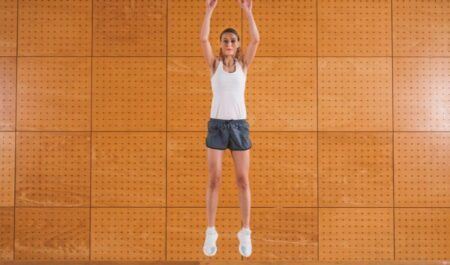
- Maintain an upright stance with your arms resting at your sides.
- Jump up in a straight line while simultaneously lifting your arms over your head.
- It should be done ten times.
Single Leg Hops
- Maintain an upright stance with your arms resting at your sides.
- Perform a standing jump up on one leg while simultaneously lifting your arms above your head.
- It should be done ten times.
You may also hop from side to side or backward and forth while doing double leg hops, single leg hops, or hops with both legs together.
Ankle Strengthening Advantages.
Increased Movement Awareness.
Your proprioception will improve as a result of working on your ankle strength, which is one of the many advantages of doing so. The capacity of your body to keep track of its position in space while you are moving is referred to by its technical word, proprioception.
For instance, if you are going to trip or twist your ankle, your body will be aware of this and take precautions to avoid you from doing either of these mistakes.
Your proprioception may be improved by doing exercises that also help you improve your balance. The activity in which you balance on one leg while closing your eyes is very beneficial for improving your proprioception.
Proprioceptive training was shown to be useful in avoiding ankle sprains, according to the findings of a meta-analysis conducted in 2015.
Leg Strengthening.
Exercises that focus on strengthening the ankles also aim to improve the major leg muscles, which in turn can help you achieve a more natural walking stride.
According to the findings of a research that was completed in 2014, training for runners should begin with an approach known as “ground up,” which focuses on ankle strengthening.
High-Heel Relief.
These exercises can be beneficial in relieving the tension that is placed on the joints of your ankles as a result of wearing high heels for extended periods of time.
The Bottom Line
A workout plan should always include a variety of exercises and stretches that focus on strengthening the ankles. Ankles that are both strong and flexible provide you a stronger basis to stand on. They are essential for enhancing your performance in a variety of activities, including sports, jogging, and dance.
Even those who don’t play sports need to have sturdy ankles. These exercises can help improve your balance and stability, both of which are essential for reducing the risk of falling, especially if you are an older person.
Before beginning a new fitness plan, it is important to discuss the matter with your primary care physician, particularly if you are making a full recovery from an illness or accident.
